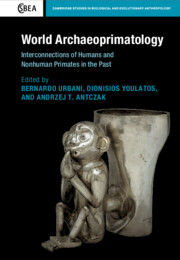Book contents
- World Archaeoprimatology
- Cambridge Studies in Biological and Evolutionary Anthropology
- World Archaeoprimatology
- Copyright page
- Dedication
- Contents
- Contributors
- Foreword
- Acknowledgments
- World Archaeoprimatology
- Part I The Americas
- 1 Monkeys in the City of Gods
- 2 Monkeys and the Ancient Maya
- 3 Monkeys on the Islands and Coasts of Paradise
- 4 Mirroring Desert Societies with Monkeys
- 5 Alterity, Authority, and Ancestors
- 6 Representations of Primates in Petroglyphs of the Brazilian Amazonia
- 7 Nonhuman Primates in the Archaeological Record of Northeastern Brazil
- 8 Lice in Howler Monkeys and the Ancient Americas
- Part II Europe
- Part III Africa
- Part IV Asia
- Index
- References
8 - Lice in Howler Monkeys and the Ancient Americas
Exploring the Potential Cost of Being Past Pets or Hunting Games
from Part I - The Americas
Published online by Cambridge University Press: 03 August 2022
- World Archaeoprimatology
- Cambridge Studies in Biological and Evolutionary Anthropology
- World Archaeoprimatology
- Copyright page
- Dedication
- Contents
- Contributors
- Foreword
- Acknowledgments
- World Archaeoprimatology
- Part I The Americas
- 1 Monkeys in the City of Gods
- 2 Monkeys and the Ancient Maya
- 3 Monkeys on the Islands and Coasts of Paradise
- 4 Mirroring Desert Societies with Monkeys
- 5 Alterity, Authority, and Ancestors
- 6 Representations of Primates in Petroglyphs of the Brazilian Amazonia
- 7 Nonhuman Primates in the Archaeological Record of Northeastern Brazil
- 8 Lice in Howler Monkeys and the Ancient Americas
- Part II Europe
- Part III Africa
- Part IV Asia
- Index
- References
Summary
Sucking lice are highly host-specific ectoparasites, particularly on primates with most lice species occurring only on a single species of host. Lice are found on prosimians, New World monkeys, Old World monkeys, and apes. The genus Pediculus is found naturally on humans (Homo sapiens), bonobos and chimpanzees (Pan), howler monkeys (Alouatta), spider monkeys (Ateles), and capuchin monkeys (Cebus). This chapter concentrates mainly on the presence of Pediculus spp. in howler monkeys to provide information on the potential louse host switch between humans and Neotropical primates. Although studies on lice in New World monkeys are very scarce and outdated, after a thorough review we found P. mjobergi reports for three species of howlers: Alouatta caraya, Alouatta guariba, and Alouatta belzebul. Genetic and paleontological evidence suggest that an interchange of genetic material between humans and howler lice occurred during encounters for example for subsistence or pets, probably when modern humans moved out of Africa and entered the Americas, and that P. mjobergi, may be an evolutionary lineage of P. humanus.
Lice, Pediculus, Alouatta, Host-switch, Peopling of the Americas, New World primates
- Type
- Chapter
- Information
- World ArchaeoprimatologyInterconnections of Humans and Nonhuman Primates in the Past, pp. 183 - 198Publisher: Cambridge University PressPrint publication year: 2022

